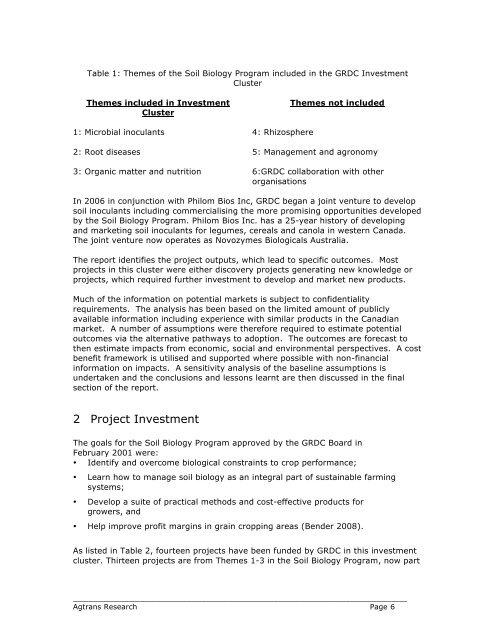impact assessment report series - Grains Research & Development ...
impact assessment report series - Grains Research & Development ...
impact assessment report series - Grains Research & Development ...
You also want an ePaper? Increase the reach of your titles
YUMPU automatically turns print PDFs into web optimized ePapers that Google loves.
Table 1: Themes of the Soil Biology Program included in the GRDC Investment<br />
Cluster<br />
Themes included in Investment<br />
Cluster<br />
1: Microbial inoculants<br />
2: Root diseases<br />
3: Organic matter and nutrition<br />
4: Rhizosphere<br />
Themes not included<br />
5: Management and agronomy<br />
6:GRDC collaboration with other<br />
organisations<br />
In 2006 in conjunction with Philom Bios Inc, GRDC began a joint venture to develop<br />
soil inoculants including commercialising the more promising opportunities developed<br />
by the Soil Biology Program. Philom Bios Inc. has a 25-year history of developing<br />
and marketing soil inoculants for legumes, cereals and canola in western Canada.<br />
The joint venture now operates as Novozymes Biologicals Australia.<br />
The <strong>report</strong> identifies the project outputs, which lead to specific outcomes. Most<br />
projects in this cluster were either discovery projects generating new knowledge or<br />
projects, which required further investment to develop and market new products.<br />
Much of the information on potential markets is subject to confidentiality<br />
requirements. The analysis has been based on the limited amount of publicly<br />
available information including experience with similar products in the Canadian<br />
market. A number of assumptions were therefore required to estimate potential<br />
outcomes via the alternative pathways to adoption. The outcomes are forecast to<br />
then estimate <strong>impact</strong>s from economic, social and environmental perspectives. A cost<br />
benefit framework is utilised and supported where possible with non-financial<br />
information on <strong>impact</strong>s. A sensitivity analysis of the baseline assumptions is<br />
undertaken and the conclusions and lessons learnt are then discussed in the final<br />
section of the <strong>report</strong>.<br />
2 Project Investment<br />
The goals for the Soil Biology Program approved by the GRDC Board in<br />
February 2001 were:<br />
• Identify and overcome biological constraints to crop performance;<br />
• Learn how to manage soil biology as an integral part of sustainable farming<br />
systems;<br />
• Develop a suite of practical methods and cost-effective products for<br />
growers, and<br />
• Help improve profit margins in grain cropping areas (Bender 2008).<br />
As listed in Table 2, fourteen projects have been funded by GRDC in this investment<br />
cluster. Thirteen projects are from Themes 1-3 in the Soil Biology Program, now part<br />
_________________________________________________________________<br />
Agtrans <strong>Research</strong> Page 6

















